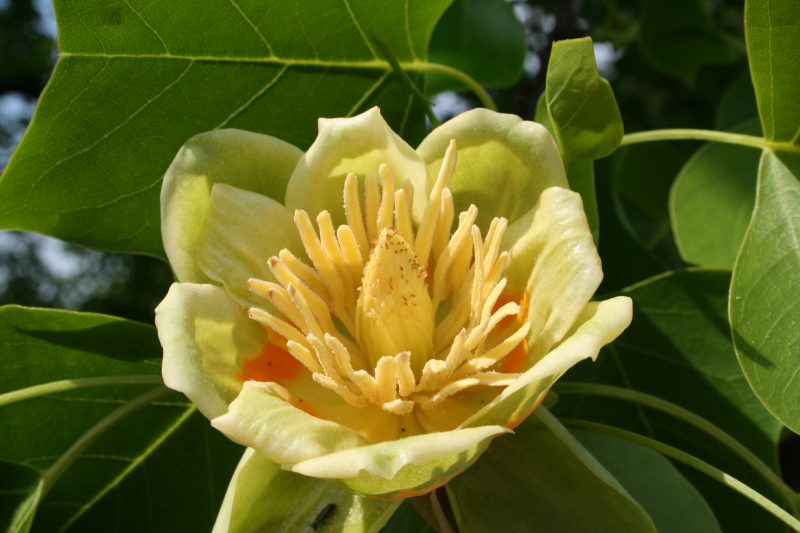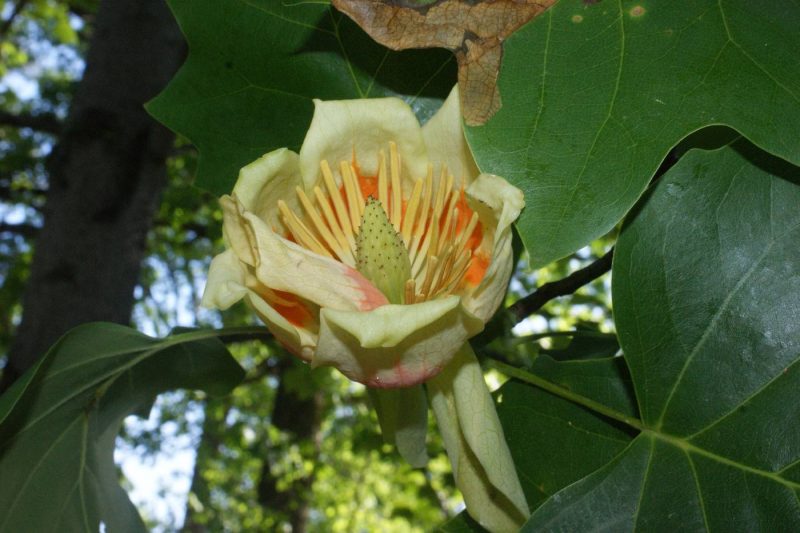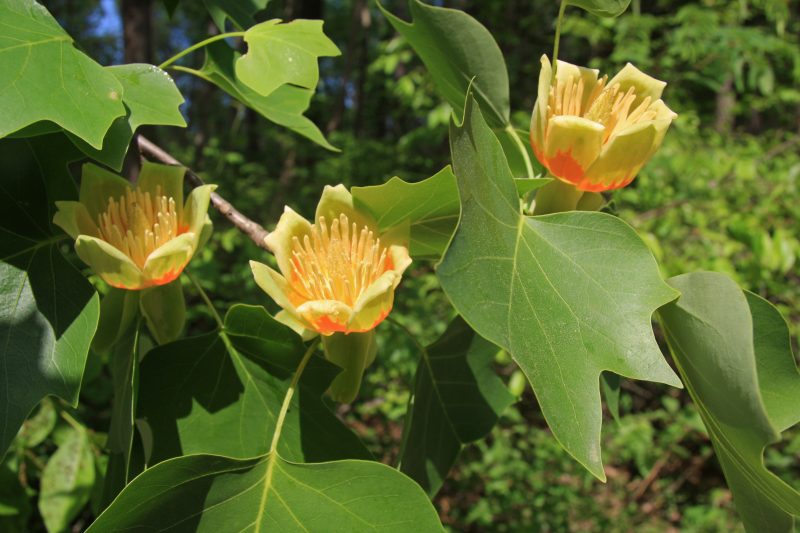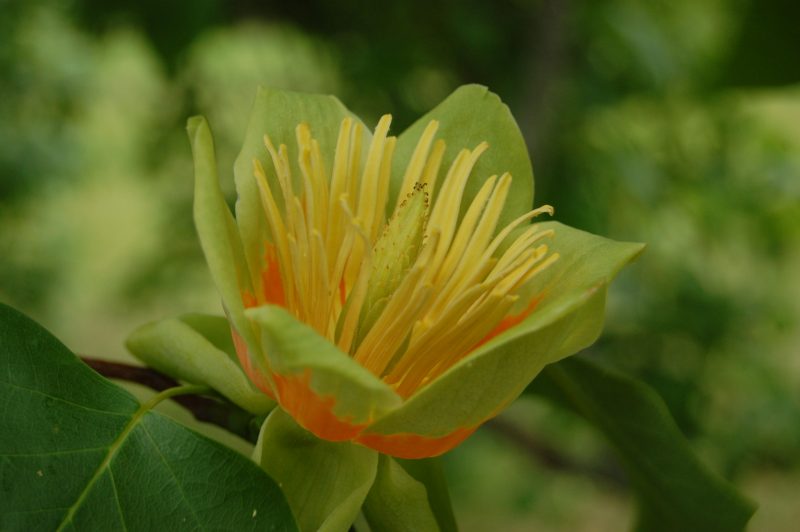Gardeners are indestructible for exotic novelties appearing on the plant market with enviable constancy. Tulip tree - from this category. Its name alone portrays a fantastic spectacle of a blossoming miracle in its imagination and, of course, moves it in search of a coveted overseas curiosity and reliable information about it.
Material Content:
Liriodendron Tulip - Botanical Description
Tulip Liriodendron (Liriodendron tulipifera) is known by several names: tulip tree, lyran, yellow poplar. The latter is not entirely correct, since the object in question belongs to a completely different family than the poplar, namely, to the Magnolievs. It is a deciduous tree, fast-growing and extremely decorative. It reaches a height of 70 m in places of natural growth, and 30 m in culture. Lives up to 500 years.
Everything is beautiful in the lyredendron: a slender trunk with a smooth bark of gray color, large lobed light green leaves with blueness, large bowl-shaped flowers with a light yellow color of petals and a faint aroma of fresh cucumber. Tulip tree blooms in June - July, and in autumn it is decorative, due to the golden yellow color of leaves fluttering in the wind, like aspen.
The flowering of varietal lirodendron is first observed at the age of not earlier than 10 years, and species forms bloom only after 20.
In the natural environment, a tulip tree is found in a vast territory from the southern border of Canada to the North American states of Florida and Arkansas. In Europe, it is grown only in culture, the northern borders of its distribution extend to Norway, which gives confidence in the possibility of its introduction in Russia.
Soil preparation and planting seedlings
Given the fact that lyriodendron requires special conditions for growing (especially at a young age), then the appropriate place for it should be selected:
- well lit from all sides;
- not in a draft, because the branches are rather fragile;
- taking into account the impressive size in the adult state.
Unlike species plants, lyredendron garden cultivars have a compact shape and restrained growth power. But at the same time, they, unfortunately, are less adapted to conditions 4 and 5 of the USDA zone.
The fertile, well-permeable soil is ideal for planting a tulip tree. The composition is suitable for sandy or loamy soils, slightly acidic or neutral, without the presence of lime.
Planting a tulip tree is possible only in the spring, before buds open. The plant has a fragile core root, deep in the soil, so you need to buy lyriodendron only at a young age and only with the ZKS (closed root system).
- The landing pit is prepared taking into account the size of the earthen coma, with which the purchased seedling must be transplanted into the open ground.
- At the bottom of the pit, drainage is laid from a layer of broken brick, gravel or coarse sand, and long-term special fertilizers are added to the fertile mixture for planting (up to 100 g per plant).
- At the end of the work, the seedling should be abundantly watered and tied to stakes on both sides of the trunk. This measure will facilitate the further formation of the standard tree with an even beautiful trunk.
Tulip Tree Care Features
The plant requires attention and care only in the first few years of life. In the year of planting, tulip tulips are not fertilized, in the future - according to the usual scheme for ornamental plants (3 times per season).
To maintain the standard shape, the tree needs annual pruning in early spring. All shoots appearing below the skeletal branches and knocked out of the contours of the future crown are removed completely or shortened.
Attention! An adult plant tolerates pruning worse, so the main formation is conducted up to 10 years of age.
The plant must be regularly watered, mulching the trunk circle and weeding. These are the basic measures for caring for a tulip tree. In the first 2 - 3 winters, the plant needs shelter, which is organized using all available means: from wrapping the stem with non-woven material to the construction of special frames from plywood and battens. The limit of frost resistance of lyriodendron is -25 - 30 ° С (short-term).
An obligatory measure of caring for any exotic culture for better adaptation to winter is early autumn root dressing with potassium-phosphorus fertilizer and treatment with any biostimulant (Epin, Zircon, HB-101, etc.) on the leaves.
Tree propagation methods
Despite the low germination rate (2 - 5%), seed propagation is one of the most common methods for lyriodendron, since it will not be possible to dilute it using any other method, except for obtaining layering. The plant is cuttings badly.
- Sowing is done with fresh seeds immediately after harvest in the fall or in the spring after 1 - 1.5 months of stratification.
- Not every material is suitable for business. Seeds should be collected from winter-hardy forms growing in Norway, on the border of the USA and Canada, or from those rare adult specimens that bloom and bear fruit in the territory of Belarus, the Moscow Region and the Central Black Earth regions of Russia.
- To increase the germination capacity of liriodendron seeds, removal of part of the buds on the plant and artificial pollination of the remaining flowers are used.
Reproduction by layering is carried out in cultivars in order to maintain maternal properties - decorative coloring of leaves, crown shape, stunting, etc.
Diseases and Pests
Liriodendron tulip is considered one of the best park trees in the world, not only because of its decorativeness, but also its resistance to diseases and pests, immunity to gas, soot and other environmental pollution.
Problems in the form of fungal diseases arise when crowded close landing in conditions of high humidity. Lack of watering leads to drying out of the ends of the leaves, and a deficiency of nutrients leads to a change in their color.
Read also:vinegar tree: planting and care
Thanks to artificial selection, the tulip tree is confidently “moving” to the north, along with such low-resistance crops as mulberry, hazelnuts, robinia, or scoopia. And not by chance. After all, this is one of the most beautiful trees in the world, the care of which pays off with interest.

















